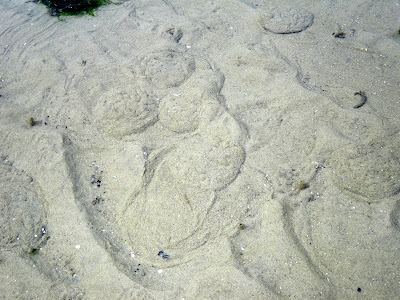
Time was short and I quickly made down to the coral rubble to catch the lowest tide. And it was heartening to see a pinkish Knobbly sea star (Protoreaster nodosus) just near the Chek Jawa beacon. I remember that they were not sighted for eight months after the mass death event. Many had died due to the extremely low salinity which were recorded to reach below 10ppt. Click here to see a photo of a dying Knobbly sea star shot by Ron during Jan 2007.

Aren't we glad that there are now back? Today, not only did I see one or two...

But actually three of them! I will later send these photos to Chee Kong for his Star Tracker monitoring.

More stars that can be found at the coral rubble include the various sizes of the Biscuit seastars (Goniodiscaster scaber).

But another sweet find at the coral rubble is this large adult-sized Cake sea star (Anthenea aspera). It was very much bigger than my palm!

The carpet anemones Haddon's carpet anemones (Stichodactyla haddoni) near the coral rubble facing Sekudu are doing very well.

There are many of them and it was difficult to avoid stepping on any of these large anemones.

Though much of the corals seem to be affected after the mass flooding of rainwater, two colonies of the Pore corals (Porites sp.) were found. I hope there are more of these huge corals at the deeper waters, which I didn't get to check because the tide was not exactly super low.

Zoanthids were also scarce and I only spotted two small patches of them.

That goes the same for the sponges. Chek Jawa used to be home to lots of colourful and good growths of different types of sponges. It was not too easy to find them today.
But all these does not mean that the coral rubble is not doing well. As said, the tide today was not low enough and it is possible for the more delicate animals to be found more abundantly at the deeper waters.

I went to check out the pillars of the boardwalk and was quite glad to find more sponges of different colours encrusted onto them.

More sponges and ascidians attached on the pillars.
Weirdly, I didn't spot any of the Pink flowery soft coral (Family Nephtheidea) that were previous seen at the rubble and the pillars of the boardwalk. I did see one colony of Sea fans (Order Gorgonacea) though.

I quickly went over to the seagrass lagoon and main sandbars to check out the animals there. The carpet anemones are still there as usual as well as the large numbers of the Cake sand dollars (Arachnoides placenta) that crowded many parts of the sandy shore.

These sand dollars leave imprints on the sand that are circular in shape. I didn't find any of the rarer keyhole sand dollar though.

It was day time and most of the abundant sand stars (Astropecten sp.) had burrowed into the sand since they are norturnal in nature.

I was on the lookout for the Common sea stars (Archaster typicus) by the five-arm marks on the sand but instead stumbled upon a brittlestar.

Good thing was that Adelle later showed me one of the common sea star. I heard from her that many of them have been spotted during the guided walks. This is good news.

I guess at the sand bar, the most drastic change in terms of population will be the Garlic bread sea cucumber (Holothuria scabra)! They are very common today considering many others are buried under the sand. Who knows how many is now at Chek Jawa. We do not need another mass death to suddenly see tons of these poor cucumbers die and surface on the sand.

How about peacock anemones (Order Ceriantharia).? At some parts of the seagrass lagoon, they seem to be doing well!

There's no sign of discoloration or poor growth of some sort.

I quickly walked to the north to search for the Button snails (Umbonium vestiarum) that have been missing in action for a long time.
However I couldn't find any living button snails.

There were dead shells though. A sign that they are still around somewhere, I think subtidally. They do migrate to and fro different zonations so I am not too worried.

Sunrise over Chek Jawa signifies new birth after the mass mortality event. A birth of a human being takes many years to mature, not to say an ecosystem.
Let's hope Chek Jawa has many good years more to go to recover back into its former glory, slowly but definitely surely.




























